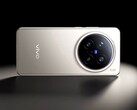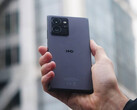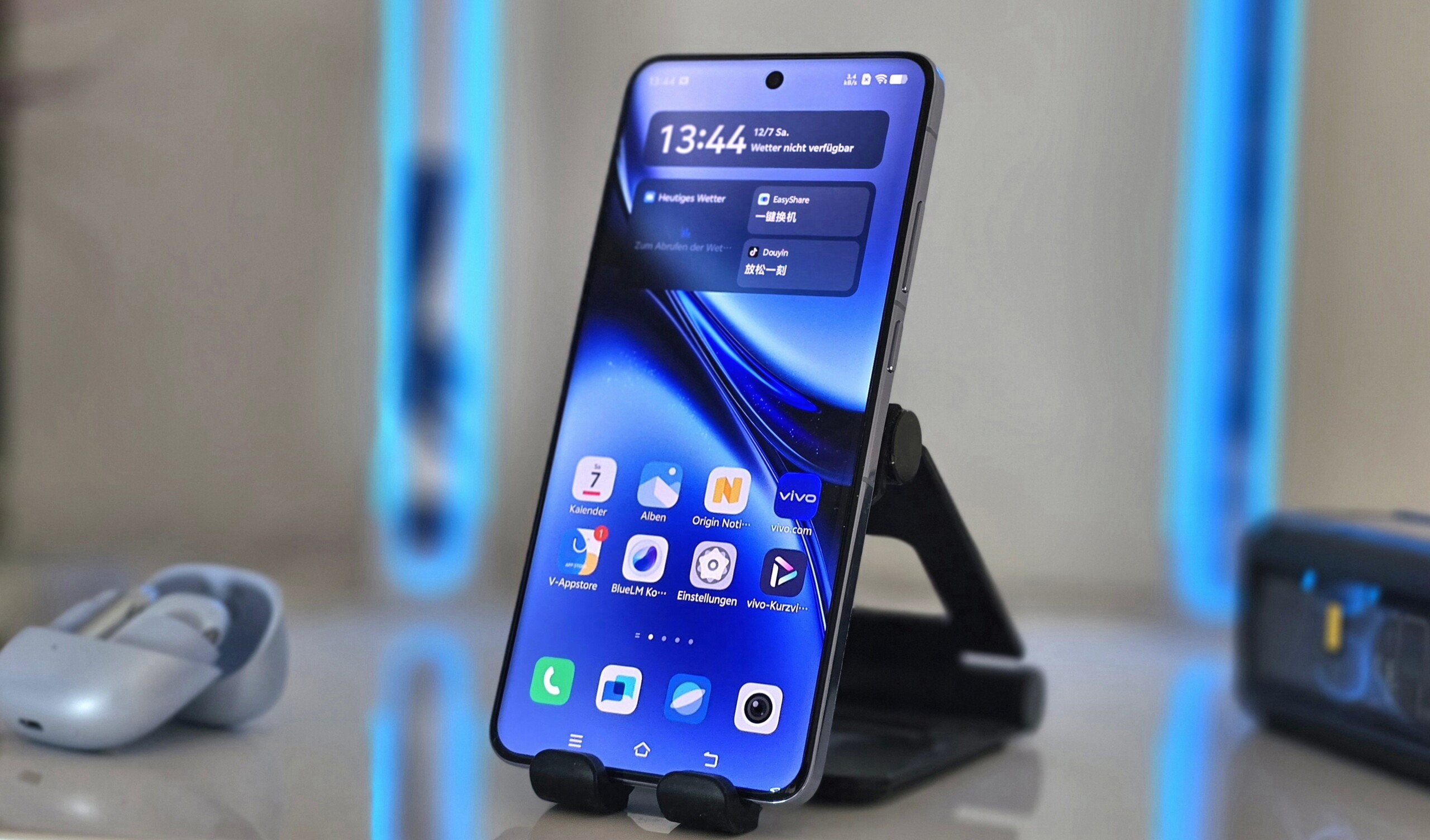
The best photo smartphone of 2024 comes with Android - Vivo X200 Pro review
Camera phone of superlatives.
The Vivo X200 Pro offers strong photo quality with its Zeiss cameras and enormous performance thanks to the flagship processor. The OLED display is also incredibly bright with over 4,800 nits in our test. Read our review of the Vivo phone to find out where it faces criticism.Marcus Herbrich, 👁 Daniel Schmidt, ✓ Anton Avdyushkin (translated by DeepL / Ninh Duy) Published 🇩🇪 🇫🇷 ...
Verdict
If you are looking for one of the best smartphones currently available in the Android segment, you cannot go past the Vivo X200 Pro. The manufacturer has made improvements to its flagship phone in many areas, including a better fingerprint sensor, a modern battery with significantly longer runtimes, and even small things that have been optimized, such as the now available option of wired image output via a USB port.
The new Dimensity 9400 is beyond any doubt in everyday use, but the MediaTek chipset should not be pushed too hard. The high waste heat leads to massive throttling, at least on the X200 Pro, which means that performance must be halved during load phases. Gamers should therefore opt for alternatives such as an Asus ROG Phone 9 Pro.
The Vivo X200 Pro also loses points when it comes to sustainability and transparency. In addition, the advanced three-year software support could be expanded. However, at the price level that the manufacturer has pursued for Europe so far, buyers of a flagship phone can certainly expect the update period of a Galaxy S24+ or Pixel 9 Pro.
Pros
Cons
Price and availability
In China, the Vivo X200 Pro starts at around 5,300 yuan (around 685 euros) in the base version (12 GB RAM, 256 GB), while the top version with 16 GB RAM and 1 TB storage costs the equivalent of around 840 euros. The Chinese manufacturer's flagship is available as an import from our rental partner Trading Shenzhen for around 850 to 980 euros.
Possible alternatives in comparison
Image | Model / Review | Price | Weight | Drive | Display |
|---|---|---|---|---|---|
| Vivo X200 Pro Mediatek Dimensity 9400 ⎘ ARM Immortalis-G925 MC12 ⎘ 15 GB Memory, 512 GB | Amazon: 1. $20.68 AKABEILA [3 Pack Privacy Scr... 2. $11.49 TNKISRY Tempered Glass for V... 3. $9.98 MAOUICI Glass for Vivo X200 ... List Price: 850€ | 223 g | 512 GB UFS 4.0 Flash | 6.78" 2800x1260 453 PPI OLED | |
| OnePlus 13 Qualcomm Snapdragon 8 Elite ⎘ Qualcomm Adreno 830 ⎘ 16 GB Memory, 512 GB | Amazon: 1. $11.98 4 Pack For OnePlus 13 Screen... 2. $11.98 2+2 Pcs For OnePlus 13 Scree... 3. $11.98 JZG 3pcs for OnePlus 13 Scre... List Price: 720€ | 213 g | 512 GB UFS 4.0 Flash | 6.82" 3168x1440 510 PPI AMOLED | |
| Oppo Find X8 Pro Mediatek Dimensity 9400 ⎘ ARM Immortalis-G925 MC12 ⎘ 16 GB Memory, 512 GB | Amazon: 1. $11.92 [1-Pack] for Oppo Find X8 Pr... 2. $15.99 AKABEILA [3 Pack Privacy Scr... 3. $9.99 WRTBS Phone Case for Oppo Fi... List Price: 1199€ | 215 g | 512 GB UFS 4.0 Flash | 6.78" 2780x1264 450 PPI AMOLED | |
| Samsung Galaxy S24+ Samsung Exynos 2400 ⎘ Samsung Xclipse 940 ⎘ 12 GB Memory, 512 GB | Amazon: $999.99 List Price: 1149€ | 196 g | 512 GB UFS 4.0 Flash | 6.70" 3120x1440 513 PPI AMOLED | |
| Vivo X100 Pro MediaTek Dimensity 9300 ⎘ ARM Immortalis-G720 MP12 ⎘ 16 GB Memory, 512 GB | Amazon: 1. $449.00 ZHIYUN MOLUS X100 RGB PRO 10... 2. $13.62 AQGGIIXY 4 Pack Tempered Gla... 3. $26.99 SmallRig Universal 67mm Magn... List Price: 1199€ | 221 g | 512 GB UFS 4.0 Flash | 6.78" 2800x1260 453 PPI AMOLED |
Table of Contents
- Verdict
- Specifications of the Vivo X200 Pro
- Case- Vivo phone with IP rating
- Features - Vivo X200 Pro with fast USB
- Software - Vivo phone with Android 15
- Communication and GNSS - Vivo X200 Pro uses dual GPS
- Calls and voice quality - Vivo phone with dual SIM
- Cameras - Vivo phone with Sony sensor
- Accessories and warranty - Vivo X200 Pro with power adapter
- Input devices & operation - Vivo phone uses face unlock
- Display - Vivo X200 Pro with OLED
- Performance - Vivo phone relies on a MediaTek SoC
- Emissions - Vivo X200 Pro with stereo sound
- Battery life - Vivo phone charges wirelessly
- Notebookcheck overall rating
The new flagship smartphone from Vivo, like the Years before, focuses on camera quality. Improvements are also expected in terms of performance and endurance thanks to the new Dimensity 9400. However, the higher efficiency of the MediaTek SoC is not the only reason for the increase in runtime. The X200 Pro uses a new battery with a silicon-carbon anode boasting a whopping 6,000 mAh.
Until now, the X200 series has not been presented as a global version, but only for the Chinese market. However, an announcement of the Vivo X200 Pro for Europe is very likely in the near future.
Specifications of the Vivo X200 Pro
Case- Vivo phone with IP rating
The Vivo X200 Pro is available in a choice of four colors (dark blue, black, white, and titanium). Thanks to the thin edges around the 6.78-inch OLED panel, the flagship phone looks very appealing and the display surface ratio of over 90% is extremely efficient. There is nothing to criticize about the build quality.
The waterproof casing with IP69 certification feels high-quality, but the metal frame and the glass back, both of which have a high-gloss finish, are quickly covered in fingerprints. The X200 Pro is also somewhat top-heavy due to the large camera module. Thanks to its high IP certification, the Vivo X200 Pro can theoretically also be cleaned with a high-pressure water jet.
Color selection of the Vivo X200 Pro (Image source: Vivo China)
Features - Vivo X200 Pro with fast USB
The Vivo flagship has a dual speaker system, an IR blaster, Bluetooth 5.4, and an NFC chip for contactless payment. The X200 Pro continues to rely on a fast USB 3.2 port, which in our copy test with an M2.SSD disk (Samsung 980 Pro) is not only fast (253 MB/s) but also supports wired image output. Connected data carriers may not only be formatted with FAT32, but also with exFAT and NTFS.
Software - Vivo phone with Android 15
Our X200 Pro presented for China uses the in-house OriginOS version 5, which is based on Android 15 and supports a variety of languages - including German. Vivo has not communicated how long it will support its flagship with updates in China. So far, it is in the range of three major Android versions and three years of security patches, which would not be very long compared to a Pixel 9 Pro or Galaxy S24 Ultra. At the time of our test, the patches are from November 2024.
The global version for Europe will probably be delivered with Funtouch OS. The latter doesn't look as modern, but unlike the Chinese version, no Chinese apps and services are pre-installed and Google applications can be used ex-works. Funtouch OS will certainly also differ in terms of AI functions. However, Google apps are also available with OriginOS via the in-house V-Appstore and a subsequently installed Play Store can be used without any problems.
Sustainability
Sustainability is not the focus of the X200 Pro, Vivo still has some catching up to do here. Information on the choice of materials or the topic of "recycling" is not communicated transparently. It is also almost impossible to check whether the device can be repaired. The packaging is probably plastic-free and was printed with inks based on soybean oil. However, the smartphone itself uses plastic materials for transportation (foil, shell).
Communication and GNSS - Vivo X200 Pro uses dual GPS
Anyone thinking about importing the X200 Pro does not need to worry about the LTE bands 20 and 28, as both frequencies are supported according to the specs. A version with satellite communication is also available for the Chinese market, although use outside of China is unlikely to be possible.
The X200 Pro supports modern WiFi 7, but the 6 GHz channel cannot be used. The flagship phone from Vivo only uses the 2.4 and 5 GHz range to establish a connection - at least in the version we tested for the Chinese market. Nevertheless, high speeds are possible with our reference router, the Asus ROG Rapture GT-AXE11000.
On a bike ride, we took a look at the positioning qualities in comparison to a Garmin Venu 2. The X200 Pro can use global satellite networks in dual bands to determine its position. Minor inaccuracies can be seen in the detailed course of the route, straight curves are often shortened. The Venu 2 is more precise overall, although the Vivo phone can be used for navigation tasks without hesitation.
Calls and voice quality - Vivo phone with dual SIM
The voice quality is very good, speech is reproduced clearly, and ambient noise is noticeably filtered out. An AI voice assistant and the Wi-Fi calling and VoLTE functions can be used on request. In addition to two physical nanoSIM cards with dual SIM function; eSIMs can only be used with the global model outside of China.
Cameras - Vivo phone with Sony sensor
The camera system of the X200 Pro is a real highlight. The new 1/1.28-inch sensor from Sony (LYT-818) is significantly smaller than the IMX989 in the X100 Pro, but in combination with the larger f/1.57 aperture, it still delivers very high photo quality.
The 50 MPix lens with OIS and Zeiss T* coating, which is designed to improve light transmission, has an extremely good HDR calculation, which means that the dynamic range and exposure are usually excellent. If you want the oversaturated colors to be displayed more neutrally in standard mode, you can fall back on ZEISS mode. However, we still see potential for improvement, especially in very low light. Here, the predecessor with its huge image sensor showed better illumination.
Apart from the main camera, the X200 Pro also has nothing to hide compared to its rivals. The new 200 MPix telephoto lens with a lossless 3.7x magnification delivers appealing photos up to a zoom level of 10x. Even when taking photos in full resolution, the Vivo phone impresses with amazingly good results, even with less-than-ideal lighting conditions - visibly better than Samsung's Galaxy S24 Ultra. Our test photos also show a lot of detail and good sharpness for the 50 MPix ultra-wide-angle lens. However, the X200 Pro reveals a weakness here, namely lens flare, which is caused by the special coating of the camera lenses. However, a software update should minimize this problem in the future.
The X200 Pro also has a lot to offer in terms of video recording. Portrait and 10-bit LOG recordings across all focal lengths, support for Dolby Vision in 4K60, and a new 4K120 slow-motion mode for the main and telephoto cameras are all on board.


Color modes in comparison: Standard (left) vs. Zeiss (right)
Image comparison
Choose a scene and navigate within the first image. One click changes the position on touchscreens. One click on the zoomed-in image opens the original in a new window. The first image shows the scaled photograph of the test device.
Main cameraMain cameraLow LightUltra wide-angleZoom 5x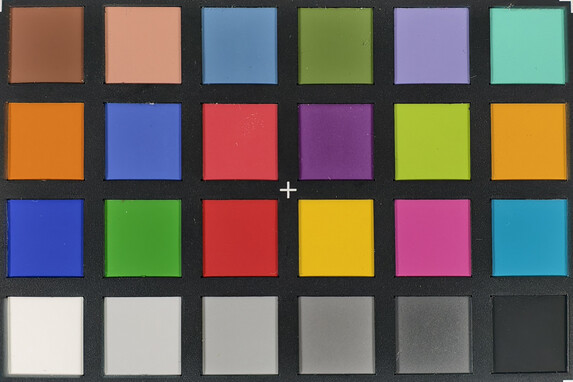
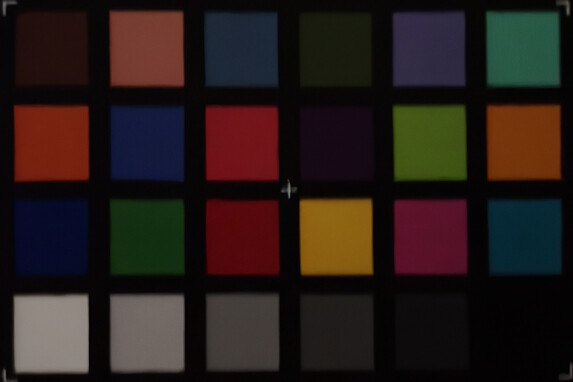
Accessories and warranty - Vivo X200 Pro with power adapter
The scope of delivery of the X200 Pro consists of a USB cable, a protective cover in the device color, and a modular 90-watt power supply unit. In addition, Trading Shenzhen includes an EU adapter for the sockets used in this country. However, this is not part of the standard scope of delivery but is a service provided by the rental company.
The Guarantee is 12 months. In the case of our test device from Trading Shenzhen, it is also possible to send the Vivo phone to a German shipping address in the event of a warranty claim. However, Vivo Europe has confirmed to us in the past that warranty claims for models purchased abroad can also be processed in Germany if the devices are officially sold in Europe.
Input devices & operation - Vivo phone uses face unlock
Inputs on the 6.78-inch 120 Hz OLED display are implemented accurately and image changes are displayed very smoothly. The linear vibration motor (X-axis) is also precise and haptically appealing.
The new 3D ultrasonic fingerprint sensor is also very good, as it is conveniently positioned high up and unlocks the X200 Pro quickly. The fact that our finger was only recognized on the second attempt hardly ever occurred during the test period. Biometric authentication via 2D facial recognition using the front camera is also offered.
Display - Vivo X200 Pro with OLED

The 6.78-inch 1,260p AMOLED panel, which is curved on all sides, not only uses advanced LTPO technology with a variable range of 1 to 120 Hz, which we can also confirm in the test, but also an eye-friendly PWM dimming of 2,380 Hz.
We achieve the enormously high peak brightness of 4,812 cd/m² when playing HDR content, but the realistic APL18 test also impresses with a very high luminosity of 2,521 cd/m².
| |||||||||||||||||||||||||
Brightness Distribution: 94 %
Center on Battery: 1828 cd/m²
Contrast: ∞:1 (Black: 0 cd/m²)
ΔE Color 0.7 | 0.5-29.43 Ø4.83
ΔE Greyscale 1.1 | 0.09-98 Ø5.1
99.6% sRGB (Calman 2D)
Gamma: 2.25
| Vivo X200 Pro OLED, 2800x1260, 6.8" | OnePlus 13 AMOLED, 3168x1440, 6.8" | Oppo Find X8 Pro AMOLED, 2780x1264, 6.8" | Samsung Galaxy S24+ AMOLED, 3120x1440, 6.7" | Vivo X100 Pro AMOLED, 2800x1260, 6.8" | |
|---|---|---|---|---|---|
| Screen | -29% | -21% | -114% | -2% | |
| Brightness middle | 1828 | 1155 -37% | 1167 -36% | 1358 -26% | 1392 -24% |
| Brightness | 1828 | 1155 -37% | 1160 -37% | 1358 -26% | 1360 -26% |
| Brightness Distribution | 94 | 98 4% | 98 4% | 92 -2% | 84 -11% |
| Black Level * | |||||
| Colorchecker dE 2000 * | 0.7 | 1 -43% | 0.87 -24% | 3 -329% | 0.6 14% |
| Colorchecker dE 2000 max. * | 1.6 | 1.8 -13% | 1.64 -3% | 4.4 -175% | 1.3 19% |
| Greyscale dE 2000 * | 1.1 | 1.6 -45% | 1.4 -27% | 2.5 -127% | 0.9 18% |
| Gamma | 2.25 98% | 2.3 96% | 2.311 95% | 1.98 111% | 2.25 98% |
| CCT | 6520 100% | 6503 100% | 6426 101% | 6656 98% | 6540 99% |
* ... smaller is better
Screen Flickering / PWM (Pulse-Width Modulation)
| Screen flickering / PWM detected | 360 Hz Amplitude: 17.65 % Secondary Frequency: 2380 Hz | ||
The display backlight flickers at 360 Hz (worst case, e.g., utilizing PWM) . The frequency of 360 Hz is relatively high, so most users sensitive to PWM should not notice any flickering. However, there are reports that some users are still sensitive to PWM at 500 Hz and above, so be aware. In comparison: 53 % of all tested devices do not use PWM to dim the display. If PWM was detected, an average of 8350 (minimum: 5 - maximum: 343500) Hz was measured. | |||
Measurement series with fixed zoom level and different brightness settings (The amplitude curve at minimum brightness looks flat, but this is due to the scaling. The info box shows the enlarged version of the amplitude at minimum brightness)
We examine the color calibration of the OLED panel using the Calman analysis software. In the "Professional" profile and the "Standard" white balance, the sRGB color space is used, which is reproduced very accurately. Our measurement with the photospectrometer results in very low average DeltaE deviations of 0.9 (colors) and 1.1 (grayscale).
Display Response Times
| ↔ Response Time Black to White | ||
|---|---|---|
| 1.43 ms ... rise ↗ and fall ↘ combined | ↗ 0.7645 ms rise | |
| ↘ 0.664 ms fall | ||
| The screen shows very fast response rates in our tests and should be very well suited for fast-paced gaming. In comparison, all tested devices range from 0.1 (minimum) to 240 (maximum) ms. » 6 % of all devices are better. This means that the measured response time is better than the average of all tested devices (20.5 ms). | ||
| ↔ Response Time 50% Grey to 80% Grey | ||
| 1.78 ms ... rise ↗ and fall ↘ combined | ↗ 0.8975 ms rise | |
| ↘ 0.882 ms fall | ||
| The screen shows very fast response rates in our tests and should be very well suited for fast-paced gaming. In comparison, all tested devices range from 0.165 (minimum) to 636 (maximum) ms. » 7 % of all devices are better. This means that the measured response time is better than the average of all tested devices (32.1 ms). | ||
Performance - Vivo phone relies on a MediaTek SoC
The MediaTek Dimensity 9400 is a high-end SoC with clock speeds of up to 3.62 GHz. Although it is not enough for the top spot in our comparison in the CPU benchmarks, the Vivo phone can still be considered very powerful. In the AI tests, however, the Dimensity 9400 sometimes achieves significantly higher values than a OnePlus 13 with the Snapdragon 8 Elite.
| UL Procyon AI Inference for Android - Overall Score NNAPI | |
| Vivo X200 Pro | |
| Average Mediatek Dimensity 9400 (75143 - 81594, n=3) | |
| Oppo Find X8 Pro | |
| Vivo X100 Pro | |
| OnePlus 13 | |
| Average of class Smartphone (1267 - 81594, n=143, last 2 years) | |
| Samsung Galaxy S24+ | |
| Geekbench AI | |
| Single Precision TensorFlow NNAPI 1.1 | |
| Vivo X200 Pro | |
| Average Mediatek Dimensity 9400 (1368 - 1543, n=2) | |
| Oppo Find X8 Pro | |
| Average of class Smartphone (122 - 4122, n=41, last 2 years) | |
| OnePlus 13 | |
| Half Precision TensorFlow NNAPI 1.1 | |
| Vivo X200 Pro | |
| Average Mediatek Dimensity 9400 (9283 - 9476, n=2) | |
| Oppo Find X8 Pro | |
| Average of class Smartphone (122 - 32120, n=41, last 2 years) | |
| OnePlus 13 | |
| Quantized TensorFlow NNAPI 1.1 | |
| Vivo X200 Pro | |
| Average Mediatek Dimensity 9400 (12709 - 13068, n=2) | |
| Oppo Find X8 Pro | |
| Average of class Smartphone (118 - 44381, n=41, last 2 years) | |
| OnePlus 13 | |
| AI Benchmark - Score V6 | |
| Average Mediatek Dimensity 9400 (9873 - 10783, n=2) | |
| Vivo X200 Pro | |
| Average of class Smartphone (68.9 - 12578, n=55, last 2 years) | |
| OnePlus 13 | |
The Immortalis-G925 is the graphics unit of the Dimensity 9400 and in the X200 Pro, it has 12 cores. Compared to an Adreno 830 the scores of the ARM GPU in the GFXBench are slightly better, while in 3DMark a OnePlus 13 performs slightly better. The former also shows that even very demanding games in 4K resolution should run at over 50 fps on the Vivo phone - at least some of the time.
GFXBench (DX / GLBenchmark) 2.7: T-Rex Onscreen | 1920x1080 T-Rex Offscreen
GFXBench 3.0: on screen Manhattan Onscreen OGL | 1920x1080 1080p Manhattan Offscreen
GFXBench 3.1: on screen Manhattan ES 3.1 Onscreen | 1920x1080 Manhattan ES 3.1 Offscreen
GFXBench: on screen Car Chase Onscreen | 1920x1080 Car Chase Offscreen | on screen Aztec Ruins High Tier Onscreen | 2560x1440 Aztec Ruins High Tier Offscreen | on screen Aztec Ruins Normal Tier Onscreen | 1920x1080 Aztec Ruins Normal Tier Offscreen | 3840x2160 4K Aztec Ruins High Tier Offscreen
| 3DMark / Wild Life Extreme Unlimited | |
| OnePlus 13 | |
| Vivo X200 Pro | |
| Oppo Find X8 Pro | |
| Vivo X100 Pro | |
| Samsung Galaxy S24+ | |
| 3DMark / Wild Life Extreme | |
| OnePlus 13 | |
| Vivo X200 Pro | |
| Oppo Find X8 Pro | |
| Vivo X100 Pro | |
| Samsung Galaxy S24+ | |
| 3DMark / Wild Life Unlimited Score | |
| OnePlus 13 | |
| Vivo X200 Pro | |
| Vivo X100 Pro | |
| Samsung Galaxy S24+ | |
| 3DMark / Solar Bay Score | |
| OnePlus 13 | |
| Vivo X200 Pro | |
| Oppo Find X8 Pro | |
| Samsung Galaxy S24+ | |
| Vivo X100 Pro | |
| 3DMark / Solar Bay Unlimited Score | |
| OnePlus 13 | |
| Vivo X200 Pro | |
| Oppo Find X8 Pro | |
| Samsung Galaxy S24+ | |
| Vivo X100 Pro | |
| 3DMark / Steel Nomad Light Unlimited Score | |
| OnePlus 13 | |
| Vivo X200 Pro | |
| Oppo Find X8 Pro | |
| 3DMark / Steel Nomad Light Score | |
| OnePlus 13 | |
| Vivo X200 Pro | |
| Oppo Find X8 Pro | |
| 3DMark / Sling Shot Extreme (ES 3.1) Unlimited Physics | |
| Vivo X200 Pro | |
| OnePlus 13 | |
| Vivo X100 Pro | |
| Samsung Galaxy S24+ | |
| 3DMark / Sling Shot Extreme (ES 3.1) Unlimited Graphics | |
| OnePlus 13 | |
| Vivo X200 Pro | |
| Vivo X100 Pro | |
| Samsung Galaxy S24+ | |
| 3DMark / Sling Shot Extreme (ES 3.1) Unlimited | |
| Vivo X200 Pro | |
| OnePlus 13 | |
| Vivo X100 Pro | |
| Samsung Galaxy S24+ | |
| GFXBench (DX / GLBenchmark) 2.7 / T-Rex Onscreen | |
| Vivo X100 Pro | |
| Vivo X200 Pro | |
| Samsung Galaxy S24+ | |
| Oppo Find X8 Pro | |
| OnePlus 13 | |
| GFXBench (DX / GLBenchmark) 2.7 / T-Rex Offscreen | |
| Vivo X100 Pro | |
| Vivo X200 Pro | |
| OnePlus 13 | |
| Oppo Find X8 Pro | |
| Samsung Galaxy S24+ | |
| GFXBench 3.0 / Manhattan Onscreen OGL | |
| Vivo X100 Pro | |
| Vivo X200 Pro | |
| Samsung Galaxy S24+ | |
| Oppo Find X8 Pro | |
| OnePlus 13 | |
| GFXBench 3.0 / 1080p Manhattan Offscreen | |
| OnePlus 13 | |
| Vivo X200 Pro | |
| Oppo Find X8 Pro | |
| Samsung Galaxy S24+ | |
| Vivo X100 Pro | |
| GFXBench 3.1 / Manhattan ES 3.1 Onscreen | |
| Vivo X100 Pro | |
| Vivo X200 Pro | |
| Samsung Galaxy S24+ | |
| Oppo Find X8 Pro | |
| OnePlus 13 | |
| GFXBench 3.1 / Manhattan ES 3.1 Offscreen | |
| OnePlus 13 | |
| Vivo X200 Pro | |
| Oppo Find X8 Pro | |
| Vivo X100 Pro | |
| Samsung Galaxy S24+ | |
| GFXBench / Car Chase Onscreen | |
| Vivo X200 Pro | |
| Vivo X100 Pro | |
| Samsung Galaxy S24+ | |
| Oppo Find X8 Pro | |
| OnePlus 13 | |
| GFXBench / Car Chase Offscreen | |
| OnePlus 13 | |
| Vivo X200 Pro | |
| Oppo Find X8 Pro | |
| Vivo X100 Pro | |
| Samsung Galaxy S24+ | |
| GFXBench / Aztec Ruins High Tier Onscreen | |
| Vivo X200 Pro | |
| Vivo X100 Pro | |
| Samsung Galaxy S24+ | |
| Oppo Find X8 Pro | |
| OnePlus 13 | |
| GFXBench / Aztec Ruins High Tier Offscreen | |
| Vivo X200 Pro | |
| OnePlus 13 | |
| Oppo Find X8 Pro | |
| Vivo X100 Pro | |
| Samsung Galaxy S24+ | |
| GFXBench / Aztec Ruins Normal Tier Onscreen | |
| Vivo X200 Pro | |
| Vivo X100 Pro | |
| Samsung Galaxy S24+ | |
| Oppo Find X8 Pro | |
| OnePlus 13 | |
| GFXBench / Aztec Ruins Normal Tier Offscreen | |
| OnePlus 13 | |
| Vivo X200 Pro | |
| Oppo Find X8 Pro | |
| Vivo X100 Pro | |
| Samsung Galaxy S24+ | |
| GFXBench / 4K Aztec Ruins High Tier Offscreen | |
| Vivo X200 Pro | |
| OnePlus 13 | |
| Oppo Find X8 Pro | |
| Samsung Galaxy S24+ | |
| Vivo X100 Pro | |
| Jetstream 2 - 2.0 Total Score | |
| OnePlus 13 (Chrome 131) | |
| Vivo X200 Pro | |
| Oppo Find X8 Pro (Chrome 131) | |
| Average Mediatek Dimensity 9400 (167.1 - 234, n=3) | |
| Vivo X100 Pro (Chrome 121) | |
| Average of class Smartphone (13.8 - 387, n=156, last 2 years) | |
| Samsung Galaxy S24+ (Chrome 121) | |
| Speedometer 2.0 - Result | |
| Vivo X200 Pro (Chrome 131) | |
| Average Mediatek Dimensity 9400 (269 - 271, n=2) | |
| Oppo Find X8 Pro (Chrome 131) | |
| Samsung Galaxy S24+ (Chrome 121) | |
| Vivo X100 Pro (Chrome 121) | |
| Average of class Smartphone (15.2 - 585, n=138, last 2 years) | |
| Speedometer 3.0 - Score | |
| OnePlus 13 (Chrome 131) | |
| Vivo X200 Pro (Chrome 131) | |
| Oppo Find X8 Pro (Chrome 131) | |
| Average Mediatek Dimensity 9400 (15 - 17.7, n=3) | |
| Average of class Smartphone (1.03 - 34, n=104, last 2 years) | |
| WebXPRT 4 - Overall | |
| OnePlus 13 (Chrome 131) | |
| Vivo X200 Pro (Chrome 131) | |
| Vivo X100 Pro (Chrome 121) | |
| Average Mediatek Dimensity 9400 (147 - 225, n=3) | |
| Samsung Galaxy S24+ (Chrome 121) | |
| Oppo Find X8 Pro (Chrome 131) | |
| Average of class Smartphone (22 - 273, n=150, last 2 years) | |
| Octane V2 - Total Score | |
| OnePlus 13 (Chrome 131) | |
| Vivo X200 Pro (Chrome 131) | |
| Average Mediatek Dimensity 9400 (56843 - 86943, n=4) | |
| Vivo X100 Pro (Chrome 121) | |
| Samsung Galaxy S24+ (Chrome 121) | |
| Oppo Find X8 Pro (Chrome 131) | |
| Average of class Smartphone (2228 - 100368, n=204, last 2 years) | |
| Mozilla Kraken 1.1 - Total | |
| Average of class Smartphone (277 - 28190, n=159, last 2 years) | |
| Vivo X100 Pro (Chrome 121) | |
| Samsung Galaxy S24+ (Chrome 121) | |
| Oppo Find X8 Pro (Chrome 131) | |
| Average Mediatek Dimensity 9400 (432 - 660, n=3) | |
| OnePlus 13 (Chrome 131) | |
| Vivo X200 Pro (Chrome 131) | |
* ... smaller is better
| Vivo X200 Pro | OnePlus 13 | Oppo Find X8 Pro | Samsung Galaxy S24+ | Vivo X100 Pro | Average 512 GB UFS 4.0 Flash | Average of class Smartphone | |
|---|---|---|---|---|---|---|---|
| AndroBench 3-5 | 16% | 6% | -23% | 39% | 18% | -24% | |
| Sequential Read 256KB | 2694.85 | 3984.23 48% | 3482.9 29% | 2450.9 -9% | 3986.41 48% | 3679 ? 37% | 2144 ? -20% |
| Sequential Write 256KB | 2174.26 | 3684.36 69% | 3498.5 61% | 1523.87 -30% | 3461.77 59% | 3102 ? 43% | 1737 ? -20% |
| Random Read 4KB | 317.29 | 301.29 -5% | 375.7 18% | 387.42 22% | 450.24 42% | 382 ? 20% | 293 ? -8% |
| Random Write 4KB | 658.43 | 344.63 -48% | 100.4 -85% | 176.19 -73% | 709.25 8% | 469 ? -29% | 334 ? -49% |
Games
Emissions - Vivo X200 Pro with stereo sound
Temperature
The pronounced heat development of the X200 Pro ensures high surface temperatures of almost 47 degrees in our Burnout benchmark scenario. In the Wild Life Stress tests of 3DMark, this leads to a high to very high throttling of the system performance of up to 60 percent. It is very likely that this also causes a reduction in performance in everyday use, for example, when gaming in summer. In some cases, the performance level is therefore even below that of the Predecessor.
(-) The maximum temperature on the upper side is 46.9 °C / 116 F, compared to the average of 35.1 °C / 95 F, ranging from 21.9 to 63.7 °C for the class Smartphone.
(±) The bottom heats up to a maximum of 43.6 °C / 110 F, compared to the average of 34.1 °C / 93 F
(+) In idle usage, the average temperature for the upper side is 27.6 °C / 82 F, compared to the device average of 32.8 °C / 91 F.
3DMark Steel Nomad Stress Test
| 3DMark | |
| Wild Life Stress Test Stability | |
| Oppo Find X8 Pro | |
| Samsung Galaxy S24+ | |
| OnePlus 13 | |
| Vivo X100 Pro | |
| Vivo X200 Pro | |
| Wild Life Extreme Stress Test | |
| Samsung Galaxy S24+ | |
| Vivo X100 Pro | |
| Oppo Find X8 Pro | |
| OnePlus 13 | |
| Vivo X200 Pro | |
| Solar Bay Stress Test Stability | |
| Samsung Galaxy S24+ | |
| Oppo Find X8 Pro | |
| Vivo X200 Pro | |
| OnePlus 13 | |
| Vivo X100 Pro | |
| Steel Nomad Light Stress Test Stability | |
| Oppo Find X8 Pro | |
| Vivo X200 Pro | |
| OnePlus 13 | |
Speaker
The Vivo X200 Pro relies on an appealing dual speaker system with minimal bass. Our pink noise measurement shows an ascending frequency curve for the mids and a slight dip in the treble. If you want to use a sound output with external devices, you can use the wired USB port or wireless Bluetooth 5.4.
Vivo X200 Pro audio analysis
(+) | speakers can play relatively loud (91.6 dB)
Bass 100 - 315 Hz
(-) | nearly no bass - on average 21.5% lower than median
(+) | bass is linear (6.4% delta to prev. frequency)
Mids 400 - 2000 Hz
(±) | reduced mids - on average 5.5% lower than median
(+) | mids are linear (4.4% delta to prev. frequency)
Highs 2 - 16 kHz
(±) | higher highs - on average 5.1% higher than median
(+) | highs are linear (3.4% delta to prev. frequency)
Overall 100 - 16.000 Hz
(±) | linearity of overall sound is average (16.9% difference to median)
Compared to same class
» 8% of all tested devices in this class were better, 7% similar, 86% worse
» The best had a delta of 12%, average was 36%, worst was 134%
Compared to all devices tested
» 28% of all tested devices were better, 7% similar, 64% worse
» The best had a delta of 4%, average was 24%, worst was 134%
Samsung Galaxy S24+ audio analysis
(+) | speakers can play relatively loud (92.1 dB)
Bass 100 - 315 Hz
(-) | nearly no bass - on average 22.3% lower than median
(+) | bass is linear (5.2% delta to prev. frequency)
Mids 400 - 2000 Hz
(±) | reduced mids - on average 6.5% lower than median
(+) | mids are linear (4.8% delta to prev. frequency)
Highs 2 - 16 kHz
(±) | higher highs - on average 5.6% higher than median
(+) | highs are linear (1.8% delta to prev. frequency)
Overall 100 - 16.000 Hz
(±) | linearity of overall sound is average (17.3% difference to median)
Compared to same class
» 10% of all tested devices in this class were better, 8% similar, 83% worse
» The best had a delta of 12%, average was 36%, worst was 134%
Compared to all devices tested
» 30% of all tested devices were better, 8% similar, 61% worse
» The best had a delta of 4%, average was 24%, worst was 134%
Battery life - Vivo phone charges wirelessly
Power consumption
The Vivo phone's 6,000 mAh battery (22.53 Wh, 3.84 V) supports both 90 watts wired charging and wireless charging with a maximum of 30 watts. A charging process takes around 45 minutes with the fast-charging power supply included in the scope of delivery.
Compared to a Find X8 Pro, the Vivo X200 Pro has a slightly higher power consumption in idle mode.
| Off / Standby | |
| Idle | |
| Load |
|
Key:
min: | |
| Vivo X200 Pro 6000 mAh | OnePlus 13 6000 mAh | Oppo Find X8 Pro 5910 mAh | Samsung Galaxy S24+ 4900 mAh | Vivo X100 Pro 2700 mAh | Average Mediatek Dimensity 9400 | Average of class Smartphone | |
|---|---|---|---|---|---|---|---|
| Power Consumption | -23% | 20% | 17% | 13% | 3% | -8% | |
| Idle Minimum * | 0.43 | 0.86 -100% | 0.6 -40% | 0.43 -0% | 0.46 -7% | 0.543 ? -26% | 0.869 ? -102% |
| Idle Average * | 1.76 | 1.74 1% | 0.8 55% | 0.84 52% | 0.92 48% | 1.387 ? 21% | 1.427 ? 19% |
| Idle Maximum * | 1.83 | 1.85 -1% | 0.9 51% | 0.95 48% | 0.95 48% | 1.743 ? 5% | 1.588 ? 13% |
| Load Average * | 9.58 | 10.69 -12% | 6.8 29% | 6.76 29% | 11.72 -22% | 8.43 ? 12% | 7.16 ? 25% |
| Load Maximum * | 11.43 | 11.92 -4% | 10.9 5% | 16.42 -44% | 11.79 -3% | 11.2 ? 2% | 10.8 ? 6% |
* ... smaller is better
Power consumption: Geekbench (150 cd/m²)
Power consumption: GFXbench (150 cd/m²)
Battery life
In our practical battery tests, which are carried out with an adjusted display brightness of 150 cd/m², the device delivers an excellent runtime of almost 23.5 hours in the WLAN test.
| Vivo X200 Pro 6000 mAh | OnePlus 13 6000 mAh | Oppo Find X8 Pro 5910 mAh | Samsung Galaxy S24+ 4900 mAh | Vivo X100 Pro 2700 mAh | |
|---|---|---|---|---|---|
| Battery Runtime | |||||
| WiFi v1.3 | 1404 | 1349 -4% | 1411 0% | 1009 -28% | 1127 -20% |
Notebookcheck overall rating
Due to the wide selection of languages and the relatively low price, importing the Vivo X200 Pro makes perfect sense.
Vivo X200 Pro
- 12/20/2024 v8
Marcus Herbrich
Transparency
The selection of devices to be reviewed is made by our editorial team. The test sample was provided to the author as a loan by the manufacturer or retailer for the purpose of this review. The lender had no influence on this review, nor did the manufacturer receive a copy of this review before publication. There was no obligation to publish this review. We never accept compensation or payment in return for our reviews. As an independent media company, Notebookcheck is not subjected to the authority of manufacturers, retailers or publishers.
This is how Notebookcheck is testing
Every year, Notebookcheck independently reviews hundreds of laptops and smartphones using standardized procedures to ensure that all results are comparable. We have continuously developed our test methods for around 20 years and set industry standards in the process. In our test labs, high-quality measuring equipment is utilized by experienced technicians and editors. These tests involve a multi-stage validation process. Our complex rating system is based on hundreds of well-founded measurements and benchmarks, which maintains objectivity. Further information on our test methods can be found here.







































































 Total Sustainability Score:
Total Sustainability Score: 